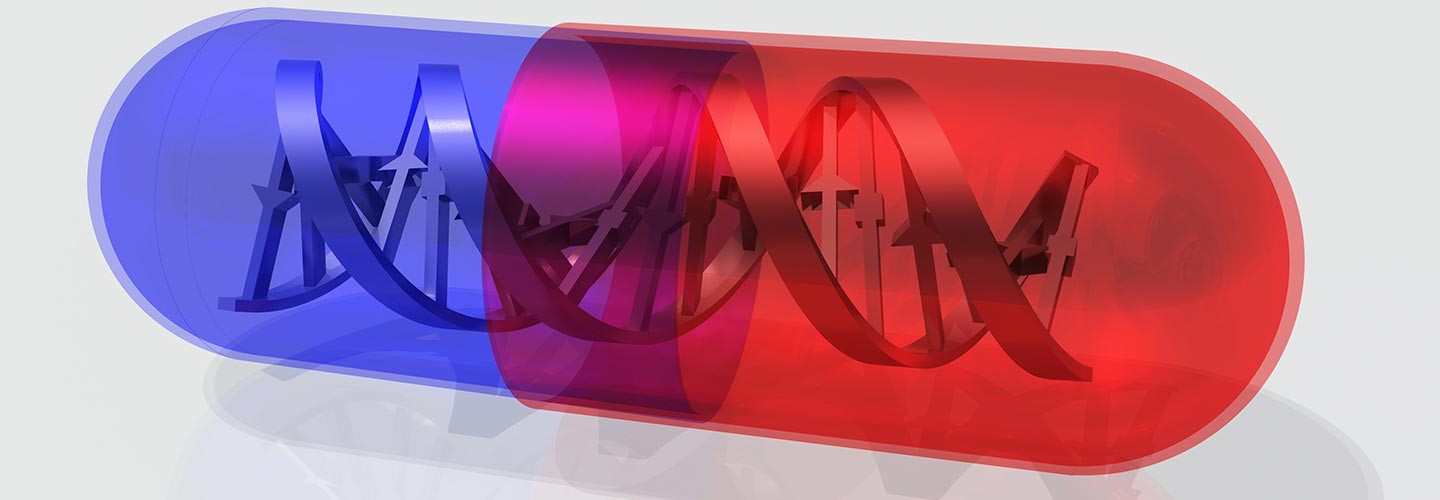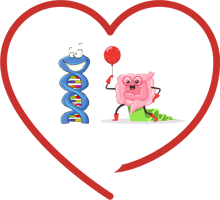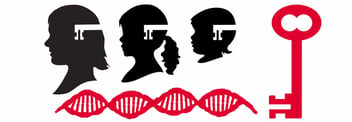DNA: I Am Who I Am… or Am I? – Session Nine
- Home
- Blog

Is Addiction Inherited?
Genetic Testing for the OPRM1 Gene, Opioid Abuse, and Alcoholism
Featuring DNA 4 TEENS! With GENiE
“It’s only us humans who want to own the future, too.”
– Tom Stoppard, The Coast of Utopia
“DNA+Evironment+Triggers+Chance = Your Future Health.
Avoid more pain by analyzing your OPRM1 gene with a simple cheek swab.”– Bruce Alan Kehr, M.D.
Reader, this week we’re talking about a gene so evocative, so consequential, that I must begin with a few urgent questions for you to consider. Please take your time:
Why did the chicken go to the séance?... To get to the other side!
How does Moses make tea?... Hebrews it.
And most importantly, how do you keep a bagel from running away?... You put lox on it.
Now, I’m no comedian, but perhaps one of these Readers’ Digest jokes elicited a guffaw once you read the punch line. Laughter can seem like such a simple if fleeting pleasure, can’t it? But if you’ve learned anything from my DNA series thus far, you surely know that nothing is just skin deep. Whether we like it or not, behind every behavior and sensation is a complex series of biological mechanisms that dictate our outcomes more than we might imagine—that includes what happens within our bodies after we read a few (corny!) jokes. As you’ll soon see, the particular reaction that clicks into place with a giggle is not always a laughing matter. Because with just one variation of a gene—OPRM1—the same system that brings you a natural high from a laugh (or from a number of other inputs, which we shall discuss) has also been associated with opioid and alcohol addiction and variations in pain sensitivity. The “G variant” of this gene may possibly lead to a greater susceptibility to addiction… particularly addiction to opioid painkillers …although the evidence is conflicting.
This is not just important information: This is a matter of life and death. With hundreds of thousands of live already lost, the opioid epidemic is the worst public health crisis in decades… and nobody is immune. Addiction to painkillers can happen to anybody. OPRM1 genetic testing can give you a greater understanding of which medications pose less risk for treating your pain—and which should be avoided as they predispose to opioid addiction. To read more about my professional take on the epidemic, you can look back through my blog archives here. Now—let’s dig in to the gene behind the pain.
Why OPRM1 Matters: OPRM1 Genetic Testing and the Possibility of Personalized Treatment
So far in this series, we have discussed a number of genes critical to furthering our understanding of our own mental health—and for each of these genes, genetic testing and epigenetic modifiers of the genetic variants that are uncovered can expedite the treatment process by allowing you and your doctor to develop a more targeted approach, with medication, supplements, or other lifestyle interventions. Previous genes covered play a direct role in increasing the vulnerability to developing depression, anxiety, bipolar disorder, and even schizophrenia. OPRM1 is a bit different, because the outcome it controls for—pain, and our reaction to it—affects us all. Pain is an inevitable part of life, and the majority of us will find ourselves in a situation where short-term use of prescription medication will be necessary for us to continue the functions of our daily lives. If you have a particular variation on your OPRM1 gene, you may be at greater risk for addiction to opioid-based medication than others who have a different variant. This question has not yet been fully answered, as we will explore in further detail below.
A Laughing Matter? How OPRM1 Functions
After some tough talk on addiction, let’s get back to those laughs we had at the beginning of this blog (at least those of us who enjoy puns!). As I mentioned, none of the sensations or behaviors we exhibit in reaction to a stimulus are ever just skin deep—a laugh is not just a laugh, but rather a switch that, when flipped on, is associated with a chain reaction of chemical processes that ultimately lead to the feeling of pleasure, joy, and euphoria… a natural “high” in other words.
OPRM1 is the gene responsible for those highs—here’s how it works. OPRM1 is involved in brain processes for reward, analgesia, and stress. It is responsible for encoding a very important protein known as the “Mu Opioid Receptor”. When it comes to understanding this protein, the name says it all. These receptors “receive” and “interpret” chemical messages that allow you to feel pleasure and relief from pain… and those chemical messengers are known as opioids. When you hear the experts talk about the harmful effects of opioids on our bodies, what they’re really referring to are exogenous opioids, or opioids that come from a source outside our bodies. But our bodies are full of naturally occurring endogenous opioids that regulate pain and reward. The Mu Opioid Receptor is primarily responsible for receiving and interpreting messages from two particular opioids in our body called endorphins and enkephalins. Our bodies create endorphins and enkephalins when we laugh, exercise, have sex, or even smell something delicious like lavender or vanilla (these are all “switches” that unlock the natural high mentioned above.) But just as a message in a bottle means nothing until it’s intercepted by someone who can read its contents, the positive feelings endorphins carry can’t be understood without a proper receptor. But when endorphins find their way to the Mu Opioid Receptor, they fit together like a completed puzzle and trigger the chemical reaction that leads to that natural high.
The mu opioid receptor receives and “unlocks” exogenous (“outside”) opioids as well—this includes oxycodone, fentanyl, hydrocodone, morphine, and others.
Now reader, research into the OPRM1 gene is still in its infancy in certain respects, and more studies need to be completed in order to paint a more precise picture of the connection between this gene and addiction. But here’s what we know so far: several variations of the OPRM1 gene have been analyzed, and those variations have led to different outcomes in patients when it comes to rates of dependence on opioid-based drugs. For instance, patients with a variation of a single amino acid (the building blocks of proteins) needed more opioid medication to achieve pain relief, possibly raising their risk of opioid addiction. This could come down to the number of opioid receptors we have in our brain cells, as dictated by our OPRM1 gene. In addition, for those who suffer from alcohol use disorders, an OPRM1 variant can help to predict a higher likelihood of a positive response to a medication called naltrexone.
Where does this leave us? Clearly, certain OPRM1 gene variants do not “cause” opioid addiction, but it is increasingly likely that some combination of OPRM1 variants along with other health, socioeconomic, and lifestyle factors interact with one another to determine an individual’s risk of developing addictions. If you remember nothing else from this series, please take away the understanding that “DNA+Evironment+Triggers+Chance = Your Future Health.” And that you can exercise a great deal of control over your “environment.”
DNA 4 TEENS! With GENiE and Dr. Novitsky
Hello again, it’s your friend GENiE with a special shout out to just my teen subscribers. Have you ever wondered why some of your friends have more trouble than others with videogame addiction (you know who I’m talking about, the one who seems to always be playing Fortnite?). The same may go for classmates who get caught up with drug or alcohol addictions. The difference may have to do with the OPRM1 Gene.

Your body has specific genes that are associated with how much “reward” or pleasure you feel when you interact with something in the environment. Your body reacts with what it is sensing by releasing feel-good chemicals, opioids. Drinking and drugs may also cause an initial increase in the pleasure chemicals. (Warning: you feel just the opposite when the effect wears off– and using/coming off substances can be life threatening and we are NOT promoting drinking or use of drugs).
Some kids have an “altered reward function” – meaning that they may feel even more of a “high” than others and may need more and more stimulus to get the same effect over time. These are the kids that are particularly at risk for addiction. This difference can be attributed to a specific type of opioid receptor (OPRM1). Genetic testing can help identify if you are at risk and can even suggest potential medication options that can help to curb the addictive tendencies.
OPRM1: The More You Know, The More You Can Take Control of Your Future
While we might like to think we are in complete control of our future, we are born with a genetic code that can cause us to react to our external world much differently than we would if we were born with just a slightly different makeup. But there’s good news here: in many instances DNA is not your destiny—at least, it doesn’t have to be. The more you know about your personal DNA, the better equipped you can become to “tweak it” and alter its expression to bring about your specific, personalized needs. Take a genetic test (like those offered by Genomind) to find out more.

DNA: I Am Who I Am… or Am I? Blog Series
- Does DNA Determine My Destiny?
- Tinker with Your Genes to Determine Your Destiny
- A Simple Cheek Swab Brings Good Karma
- Test Your DNA to Determine Your Reality
- The BDNF Gene: Use “Fertilizer” to Grow a Majestic ”Rainforest Brain”… and Introducing “GENiE” and “DNA 4 KIDS”
- The MTHFR Gene: “Manufacture” Your Way to Health and Happiness Featuring “DNA 4 KIDS” with “GENiE”
- The SLC6A4 Gene (Serotonin Reuptake Gene): Improve Your Mood and Anxiety through a Simple Cheek Swab Featuring “DNA 4 KIDS” with “GENiE”
- Tame that Emotional Roller Coaster Ride Genetic Testing for the ANK3 Gene and CACNA1C Gene Featuring “DNA 4 KIDS” with “GENiE”
- Is Addiction Inherited? Genetic Testing for the OPRM1 Gene, Opioid Abuse, and Alcoholism Featuring “DNA 4 TEENS” With “GENiE”
- Surf’s Up: Use Your Genetic Code to Ride the Stress Wave with Ease The COMT Gene Featuring “DNA 4 KIDS” With “GENiE”
- Mental Illness is not a Myth—and Human Genomics Proves It The DRD2 Gene and Dopamine Featuring “DNA 4 KIDS” With “GENiE”
- ADHD in the Age of Distraction The Tricky Genetics behind ADHD and ADRA2A Featuring “DNA 4 KIDS” With “GENiE”
- Overweight and Obesity – Is it Me, or My DNA? 5HT2C and MC4R: Can Your Genes Make You Fat?
- Is Alcoholism Inherited? Can a Tiny Gene Help Treat It? The GRIK1 Gene
- 2018 Women’s Health and Wellness Summit DNA Keynote Address
Related Information
- Learn about Genetic Testing
- Learn about Potomac Psychiatry
- Meet Our Doctors
- Contact Potomac Psychiatry
.png?width=144&height=144&name=Untitled%20design%20(34).png)



